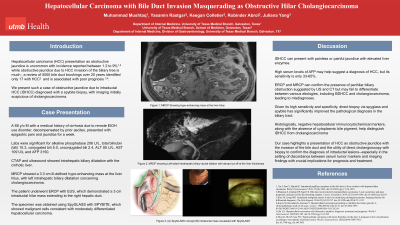Monday Poster Session
Category: Biliary/Pancreas
P1865 - Hepatocellular Carcinoma With Bile Duct Invasion Masquerading as Obstructive Hilar Cholangiocarcinoma
Monday, October 28, 2024
10:30 AM - 4:00 PM ET
Location: Exhibit Hall E

Has Audio

Muhammad Mushtaq, DO
University of Texas Medical Branch
Galveston, TX
Presenting Author(s)
Muhammad Mushtaq, DO, Yasamin Rastgar, , Keegan Colletier, MD, Robinder Abrol, DO, Juliana Yang, MD
University of Texas Medical Branch, Galveston, TX
Introduction: Hepatocellular carcinoma (HCC) presentation as obstructive jaundice is uncommon with incidence reported between 1.2 to 9% while obstructive jaundice due to HCC invasion of the biliary tree is much rarer; a review of 5000 bile duct brushings over 20 years identified only 17 with HCC which is associated with poor prognosis We present such a case of obstructive jaundice due to intraductal HCC (IDHCC) diagnosed with a spybite biopsy, with imaging initially suspicious of cholangiocarcinoma.
Case Description/Methods: A 68 y/o M with a medical history of cirrhosis due to remote EtOH use disorder, decompensated by prior ascites, presented with epigastric pain and jaundice for a week. Labs were significant for alkaline phosphatase 206 U/L, total bilirubin (bili) 10.3, conjugated bili 5.0, unconjugated bili 2.4, ALT 85 U/L, AST 109 U/L and AFP 3150. CTAP and ultrasound showed intrahepatic biliary dilatation with the cirrhotic liver. MRCP showed a 3.3 cm ill-defined hypo-enhancing mass at the liver hilus, with left intrahepatic biliary dilatation concerning cholangiocarcinoma. The patient underwent ERCP with EUS, demonstrating the 3 cm intraductal hilar mass extending to the right hepatic duct. SpyGLASS with SPYBITE was performed to obtain the specimen, which showed malignant cells consistent with moderately differentiated hepatocellular carcinoma.
Discussion: IDHCC can present with painless or painful jaundice with elevated liver enzymes. High serum levels of AFP may help suggest a diagnosis of HCC, but its sensitivity is only 33-65%. ERCP and MRCP can confirm the presence of perihilar biliary obstruction suggested by US and CT but may fail to differentiate between various etiologies, including BDHCC and cholangiocarcinoma, leading to misdiagnoses. These pathologies can be further differentiated by cytoplasmic brush sampling and biopsy. Given high sensitivity and specificity, direct biopsy via spyglass and spybite has significantly improved the pathological diagnosis in the biliary tract. Histologically, negative hepatocellular immunocytochemical markers along cytoplasmic bile pigment absence help distinguish IDHCC and cholangiocarcinoma. Our case highlights a presentation of HCC as obstructive jaundice with the bile duct and the utility of direct cholangioscopy with biopsy to confirm the diagnosis of intraductal lesions--especially in the setting of discordance between serum tumour markers and imaging findings with crucial implications for prognosis and treatment.
Disclosures:
Muhammad Mushtaq, DO, Yasamin Rastgar, , Keegan Colletier, MD, Robinder Abrol, DO, Juliana Yang, MD. P1865 - Hepatocellular Carcinoma With Bile Duct Invasion Masquerading as Obstructive Hilar Cholangiocarcinoma, ACG 2024 Annual Scientific Meeting Abstracts. Philadelphia, PA: American College of Gastroenterology.
University of Texas Medical Branch, Galveston, TX
Introduction: Hepatocellular carcinoma (HCC) presentation as obstructive jaundice is uncommon with incidence reported between 1.2 to 9% while obstructive jaundice due to HCC invasion of the biliary tree is much rarer; a review of 5000 bile duct brushings over 20 years identified only 17 with HCC which is associated with poor prognosis We present such a case of obstructive jaundice due to intraductal HCC (IDHCC) diagnosed with a spybite biopsy, with imaging initially suspicious of cholangiocarcinoma.
Case Description/Methods: A 68 y/o M with a medical history of cirrhosis due to remote EtOH use disorder, decompensated by prior ascites, presented with epigastric pain and jaundice for a week. Labs were significant for alkaline phosphatase 206 U/L, total bilirubin (bili) 10.3, conjugated bili 5.0, unconjugated bili 2.4, ALT 85 U/L, AST 109 U/L and AFP 3150. CTAP and ultrasound showed intrahepatic biliary dilatation with the cirrhotic liver. MRCP showed a 3.3 cm ill-defined hypo-enhancing mass at the liver hilus, with left intrahepatic biliary dilatation concerning cholangiocarcinoma. The patient underwent ERCP with EUS, demonstrating the 3 cm intraductal hilar mass extending to the right hepatic duct. SpyGLASS with SPYBITE was performed to obtain the specimen, which showed malignant cells consistent with moderately differentiated hepatocellular carcinoma.
Discussion: IDHCC can present with painless or painful jaundice with elevated liver enzymes. High serum levels of AFP may help suggest a diagnosis of HCC, but its sensitivity is only 33-65%. ERCP and MRCP can confirm the presence of perihilar biliary obstruction suggested by US and CT but may fail to differentiate between various etiologies, including BDHCC and cholangiocarcinoma, leading to misdiagnoses. These pathologies can be further differentiated by cytoplasmic brush sampling and biopsy. Given high sensitivity and specificity, direct biopsy via spyglass and spybite has significantly improved the pathological diagnosis in the biliary tract. Histologically, negative hepatocellular immunocytochemical markers along cytoplasmic bile pigment absence help distinguish IDHCC and cholangiocarcinoma. Our case highlights a presentation of HCC as obstructive jaundice with the bile duct and the utility of direct cholangioscopy with biopsy to confirm the diagnosis of intraductal lesions--especially in the setting of discordance between serum tumour markers and imaging findings with crucial implications for prognosis and treatment.
Disclosures:
Muhammad Mushtaq indicated no relevant financial relationships.
Yasamin Rastgar indicated no relevant financial relationships.
Keegan Colletier indicated no relevant financial relationships.
Robinder Abrol indicated no relevant financial relationships.
Juliana Yang indicated no relevant financial relationships.
Muhammad Mushtaq, DO, Yasamin Rastgar, , Keegan Colletier, MD, Robinder Abrol, DO, Juliana Yang, MD. P1865 - Hepatocellular Carcinoma With Bile Duct Invasion Masquerading as Obstructive Hilar Cholangiocarcinoma, ACG 2024 Annual Scientific Meeting Abstracts. Philadelphia, PA: American College of Gastroenterology.
